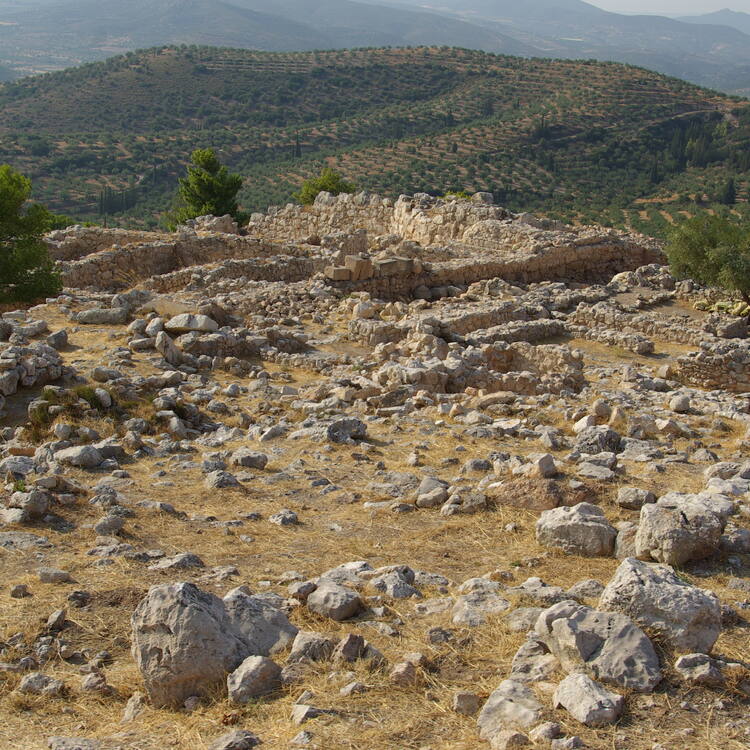Archaeological Sites of Mycenae and Tiryns
Archaeological Sites of Mycenae and Tiryns
The archaeological sites of Mycenae and Tiryns are the imposing ruins of the two greatest cities of the Mycenaean civilization, which dominated the eastern Mediterranean world from the 15th to the 12th century B.C. and played a vital role in the development of classical Greek culture. These two cities are indissolubly linked to the Homeric epics, the Iliad and the Odyssey , which have influenced European art and literature for more than three millennia.
Description is available under license CC-BY-SA IGO 3.0
Sites archéologiques de Mycènes et de Tirynthe
À Mycènes et à Tirynthe subsistent les ruines imposantes des deux plus grandes cités de la civilisation mycénienne, qui domina le monde de la Méditerranée orientale du XVe au XIIe siècle avant J.-C. et qui joua un rôle essentiel dans le développement de la culture de la Grèce classique. Ces deux cités sont indissolublement liées aux épopées homériques de l'Iliade et de l'Odyssée dont la profonde influence sur la littérature et les arts persiste depuis plus de trois millénaires.
Description is available under license CC-BY-SA IGO 3.0
مواقع ميسناي و تيرينز الأثرية
تتوافر في كلي ميسناي وتيرينز الآثار البارزة لإحدى أكبر مدينتين في الحضارة الموكينية التي سيطرت على عالم المتوسط الشرقي من القرن الخامس عشر حتى القرن الثاني عشر قبل الميلاد، والتي لعبت دوراً أساسياً في تطور ثقافة اليونان الكلاسيكية. إنّ هاتين المدينتين هما دائماً متصلتان اتصالاً وثيقاً في الحقبات الهوميرية التي تجسدها ملحمتا الإلياذة والأوديسيه صاحبتا الأثر العميق على الأدب العالمي منذ أكثر من ثلاثة آلاف سنة.
source: UNESCO/CPE
Description is available under license CC-BY-SA IGO 3.0
迈锡尼和提那雅恩斯的考古遗址
迈锡尼和提那雅恩斯是迈锡尼文明两座最伟大的城市,其遗址也十分壮观。公元前15世纪至公元前12世纪,迈锡尼文明盛行于地中海东部,在古希腊文化的发展中发挥了重要作用。这两座城市还与荷马史诗《伊利亚特》和《奥德赛》有着密切的关联,而这两部史诗对欧洲艺术和文学的影响则持续了3000多年。
source: UNESCO/CPE
Description is available under license CC-BY-SA IGO 3.0
Археологические памятники Микен и Тиринфа
Археологические памятники Микен и Тиринфа – это величественные руины двух наиболее значительных городов Микенской цивилизации, которая доминировала в Восточном Средиземноморье в ХV-ХII вв. до н.э., и сыграла жизненно важную роль в развитии классической древнегреческой культуры. Эти два города, бесспорно, связаны с эпосами Гомера «Илиадой» и «Одиссеей», оказывавшими влияние на искусство и литературу Европы на протяжении более трех тысячелетий.
source: UNESCO/CPE
Description is available under license CC-BY-SA IGO 3.0
Sitios arqueológicos de Micenas y Tirinto
En estos sitios arqueológicos se hallan las impresionantes ruinas de dos de las ciudades más importantes de la civilización micénica, que dominó la región del Mediterráneo oriental entre los siglos XV y XII a.C. y desempeñó un papel esencial en el desarrollo de la cultura de la Grecia clásica. Las ciudades de Micenas y Tirinto están indisolublemente unidas a las dos epopeyas homéricas, la Ilíada y la Odisea, cuya influencia en la literatura y las artes europeas perdura desde hace tres milenios.
source: UNESCO/CPE
Description is available under license CC-BY-SA IGO 3.0
ミケーネとティリンスの古代遺跡群
ミケーネはペロポネソス半島北部、ティリンスは同半島東部に位置する古代都市遺跡。ともに紀元前15世紀から紀元前1200年にかけて東地中海世界に覇をとなえ、クレタ文明後期にあたるミケーネ文化の発展に重要な役割を果たした。ミケーネは伝説ではトロイ戦争の英雄アガメムノン王の首都。トロイ遺跡の発掘に成功したシュリーマンが2年後の1876年ミケーネ遺跡を発掘し、1884~85年にはティリンスの発掘にも成功した。source: NFUAJ
Archeologische steden Mycene en Tiryns
De Myceense beschaving heeft zich ontwikkeld op het Griekse vasteland in de late bronstijd (16e eeuw voor Christus). De archeologische plaatsen van Mycene en Tiryns bestaan uit de indrukwekkende ruïnes van de twee grootste steden van de Myceense beschaving. Deze domineerden het oostelijk Middellandse Zeegebied van de 15e tot de 12e eeuw voor Christus en speelden een belangrijke rol in de ontwikkeling van de klassieke Griekse cultuur. De twee steden zijn onlosmakelijk verbonden met de Homerische epen, de Ilias en de Odyssee, die van invloed waren op de Europese kunst en literatuur gedurende meer dan drie millennia.
Source: unesco.nl
Outstanding Universal Value
Brief synthesis
The Archaeological Sites of Mycenae and Tiryns, located in the Regional unit of Argolis in the North-East Peloponnese, are the imposing ruins of the two greatest cities of the Mycenaean civilization, renowned for its technical and artistic achievements but also its spiritual wealth, which spread around the Mediterranean world between 1600 and 1100 BC and played a vital role in the development of classical Greek culture. The palatial administrative system, the monumental architecture, the impressive artefacts and the first testimonies of Greek language, preserved on Linear B tablets, are unique elements of the Mycenaean culture; a culture that inspired the great poet Homer to compose his famous epic poems.
The citadel of Mycenae, with its strategic position for the control of the Argolid Plain, is the kingdom of the mythical Agamemnon and the most important and richest palatial centre of the Late Bronze Age in Greece. Its name was given to one of the greatest civilizations of Greek prehistory, the Mycenaean civilization, while the myths related to its history, its rulers and their family members (such as Klytaimnestra, Ifigeneia, Elektra, Orestes) have inspired poets, writers and artists over many centuries, from the ancient to the contemporary times. Significant stages in monumental architecture are still visible in the property, such as the massive defensive walls, the corbelled tholos tombs and the Lions Gate.
Tiryns, situated 20 km north-east of Mycenae on a low hill near the inlet of the Argolic Gulf, is another excellent example of the Mycenaean civilization. The fortification of the hill, completed at the end of the 13th century BC, surrounds the citadel with a total perimeter of approximately 750 m. The impressive walls, built of stones even larger than those of Mycenae, are up to 8 m thick and 13 m high. They can rightly be regarded as a creation that goes beyond the human scale, as reveals the word “cyclopean” – built by Cyclops, the mythical giants from Lycia – which was attributed to them in the Homeric epics.
Criterion (i): The architecture and design of Mycenae and Tiryns, such as the Lion Gate and the Treasury of Atreus and the walls of Tiryns, are outstanding examples of human creative genius.
Criterion (ii): The Mycenaean civilisation, as exemplified by Mycenae and Tiryns, had a profound effect on the development of classical Greek architecture and urban design, and consequently also on contemporary cultural forms.
Criterion (iii): Mycenae and Tiryns bear unique testimony to the political, social and economic development of the Mycenaean world, thus representing the peak of this early stage of Greek civilization.
Criterion (iv): Both sites illustrate in a unique manner the achievements of Mycenaean civilization in arts, architecture and technology, which laid the foundations for the evolution of later European cultures.
Criterion (vi): Mycenae and Tiryns are intricately linked with the Homeric epics, the Iliad and the Odyssey, which profoundly influenced European literature and arts for more than three millennia.
Integrity
Both sites contain within their boundaries all the key attributes that convey their Outstanding Universal Value, bequeathing the spirit of the Mycenaean civilization from antiquity to the world of today. Their integrity is ensured primarily by the strict legal framework, which prohibits any construction within the boundaries of the sites and provides for the maintenance of the agricultural character of their surrounding area. Both sites are under the constant surveillance and monitoring of the Hellenic Ministry of Culture, Education and Religious Affairs. On-going archaeological research projects are conducted on both sites, aiming at further exploring the history and values of the property. These are carried out in a systematic way, taking into consideration all the international standards relating to archaeological fieldwork. The excavated monuments are building complexes or funerary monuments of big scale that are in a good state of preservation. Thus the integrity of the property is not compromised by the excavations, as all the necessary conservation interventions are simultaneously undertaken.
Authenticity
The authenticity of both sites is unquestionable. Monuments of Mycenae maintain their authenticity since the various restoration works carried out in the past were based on the international standards for the intervention on monuments, on archaeological evidence and on architectural remains of the Mycenaean period. Special studies based on the principle of reversibility have preceded all interventions.
The authentic character of the citadel of Tiryns is also well preserved. The interventions that took place during the 1950’s were mild and compatible to the original building system. Moreover, restoration works carried out in 1998-2005 were based on the original construction methods, thereby preserving all the architectural elements of the Mycenaean period.
Protection and management requirements
Both sites are protected under the provisions of the Greek Antiquities Law No 3028/2002, on the “Protection of Antiquities and Cultural Heritage in general”. The boundaries of the archaeological site of Mycenae and its buffer zone were established by Ministerial Decree No 2160 of 1964. Protection extends to the Citadel (Acropolis), the areas outside the walls and the wider surrounding area, including the natural environment of the site. The site of Tiryns is covered by Ministerial Decrees No 102098/4753 of 1956 and 12613/696 of 1991.
The property is under the jurisdiction of the Ministry of Culture, Education and Religious Affairs, through the Ephorate of Antiquities of Argolis, its competent regional service. In 1999, a scientific Committee for Mycenae was established, which carried out several projects of stabilization, conservation and enhancement of the site. Special attention was given to the accessibility of monuments by all visitors, and to other visitor’s facilities, such as an extensive network of pathways, stations and informative material.
The interpretation of the property is complemented by an archaeological museum, founded in 2003. Its collection comprises a great number of artefacts of Prehistoric and Historic times, giving special emphasis to the presentation of the Mycenaean period.
On both sites, systematic archaeological excavations are being carried out, while restoration works are conducted and others are scheduled. In Tiryns, the restoration project is jointly funded by the Greek state and the European Union. Restoration works in Mycenae, such as the restoration of the Tomb of the Lion, would further enhance the Outstanding Universal Value of the property, while the improvement of the network of ancient roads connecting Mycenae to other archaeological sites of the area (Heraion and Prosymna) would enhance our understanding of the broader area in antiquity.


